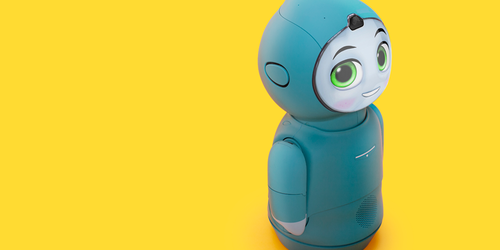 BACK TO HOMEPAGE >
BACK TO HOMEPAGE >

Moxie by Embodied | 2020
Designers: fuseproject, San Francisco, California, USA
Manufacturer: No. 29, New York City, New York, USA
What role can an AI-equipped, smart companion play in the ever-evolving world of health & wellness? How can parents better support their children during their developmental years as they learn new social skills?
These are some of the questions fuseproject aims to address with the launch of Moxie, a revolutionary animate companion from Embodied, Inc. that is designed to help all children across the ability spectrum—from neurotypical to neurodivergent—build social, emotional, and cognitive skills through everyday play-based learning and engaging content.
Embodied has assembled a world class team of experts in child development, engineering, technology, game design, and entertainment to build a robot with machine learning technology that allows it to perceive, process and respond to natural conversation, eye contact, facial expressions and other behavior as well as recognize and recall people, places, and things.
Tall enough to be of interest without being unwieldy, Moxie measures in at 387mm tall and is designed to work with children between the ages of 5-10; however, younger children can also use Moxie with some assistance.
The team took special care in collaborating with Embodied to define and balance several of the smart companion’s key features including its facial expression, overall shape, color palette, and exterior materiality.
To align with the technology used to light the face and signal nuanced, complex feelings like vulnerability, interest, or concern, the team created a simpler and more perceptible face without details like wrinkles and shadows.
Moxie’s large, friendly eyes and expressive face were critical features that were integrated into the design to protect children from excessive screen-time, help them more easily recognize certain emotions, and make the interaction experience feel all the more real.
The team iterated and redefined the model into a body type with smoother transitions along its limbs and balanced bodily proportions consistent with and complimentary to Moxie’s facial appearance.
Integrating all the engineering components and technology into its frame was challenging—particularly with Moxie’s detailed form designed specifically to encourage interaction and resonate with children.
All its expressive and endearing features—including the ears, head/playful projection tip, speakers, and arm/hand/finger details—come together to tell an otherworldly story about Moxie as a friendly companion from The Global Robotics Laboratory (G.R.L.) sent out as a robot ambassador with a mission to learn what it means to be a good friend to humans.
The fuseproject team designed the head with a slightly projected silhouette tip visible from the side profile. This form defines Moxie’s playful head shape, while also giving more character and life to its personality.
Moxie’s uniform includes its signature profile tip (that also doubles as his helmet), gloves, and triangular badge on its chest.
Moxie’s ears are an opportunity for interaction and visually signify that the smart companion can hear. Children are able to whisper secrets and communicate with Moxie through its teardrop shaped ears on the sides of its head.
The ears, speaker, and microphone are the major components that allow Moxie to interact, they are designed to foster interaction while being based on Moxie’s internal components and locations.
Designing and simplifying a hand shape was an interesting challenge. Our approach is a simplified hand with an index finger that is pointed and a thumb silhouette.
This minimal approach was simpler than a fully articulated hand, while delivering visual cues for kids interaction and games.
The iconic hand creates a universally recognizable signal and simple level of communication: index finger to point, indicate interest, or ask a question.
The high-performance thermoplastic elastomer (TPE) overmolded material also wraps around Moxie’s hands, allowing it to point with a simple one finger gesture to play games.
These design parameters and their collective interactions are important for establishing Moxie’s anthropomorphism and ability to traverse uncertain sensory data in an unpredictable environment like working with children.
Moxie engages with children with its entire body. It can turn 360-degrees on its base to react to its child and effortlessly bend at the neck, belly, and base.
While the possibilities are endless as to how interactions between children and Moxie can evolve with machine learning, fuseproject’s design approach prioritizes the most impactful and defining features for the targeted age group:
Adaptive. The face—its facial cues and expressions, namely—plays a critical and adaptive role in interaction by communicating to the child the condition, intention, or need of Moxie.
Companion. While durable, a soft-touch coating in a gender-neutral bluish teal tone is used to “clothe” Moxie so that it can respond with tactility when touched or held.
Integrated. The integrated design lends itself to a playful backstory of Moxie as a friendly companion from the Global Robotics Laboratory (G.R.L.) through its sleek space uniform, badge that displays battery level and communication status, and endearing helmet shape.
Learner. From the moment Moxie says hello, it begins to learn. Over time, Moxie learns more and more about the child to better connect and help with developmental goals. Moxie’s cutting-edge machine learning technology allows it to perceive, process, and react to natural behavior. Moxie can also recognize and recall people, places, and
things. This makes the experience more natural, personal, and effective.
Operable via the Embodied Moxie Parent App, Moxie provides families with the tools to support continued growth and learning at home for their children.
Designed with gestures and materials to fit seamlessly into the home, Moxie enhances the experiences children can have every day and provides an opportunity to mentally, emotionally, and socially engage with their trusted companion.


